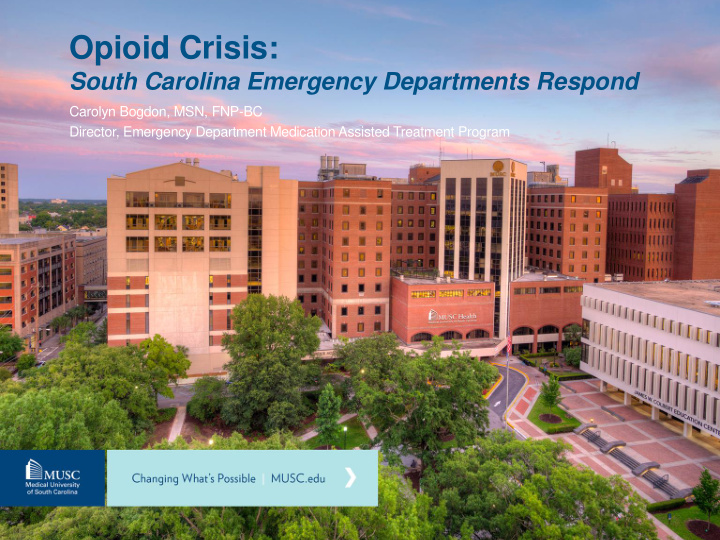



Opioid Crisis: South Carolina Emergency Departments Respond Carolyn Bogdon, MSN, FNP-BC Director, Emergency Department Medication Assisted Treatment Program
Problem Addressed • ED is first point of health care contact • Nearly 5 million opioid related ED visits • Over 8,000 discharged from SC EDs without immediate access to life saving, on demand treatment • ED initiated MAT coupled with same or next day follow up: • Decreases mortality and infectious disease transmission • Decreases medical and psychiatric hospital admissions • Decreases return ED visits • Referral alone, without medication, results in < 40% follow- up rates in this population
Outcomes • Year one: Contracted with DHHS November 2017-November 2018 • 100% operationalized to initiate buprenorphine in the ED with “fast track” follow -up in 3 diverse ED systems • December 2017: MUSC • March 2018: Tidelands Waccamaw & Grand Strand Medical Center • Educated over 200 SC ED healthcare professionals
Outcomes • Within first 9 months: • > 4000 ED patients screened for substance abuse/misuse by peer recovery staff • > 1450 ED patients screened positive for substance abuse/misuse • > 475 patients screened positive for opioid use disorder • Upwards of 150 potential psychiatric hospitalizations averted through ED buprenorphine induction • Approximately 80% of inducted patients arrived to next day appointments • Averaging at least 60% retained in treatment at 30 days
SBIRT Cost Effectiveness • For every $1.00 spent on SBIRT, estimated $3.81-$5.60 return on investment. • Benefit-cost ratio: upwards of 5.6:1 • Wisconsin: reduced hospital costs, ED visits and associated problems • $1000 savings/person screened • Texas: noted a 50% reduction in alcohol related injuries • Net savings of $3.81 in ED costs/$1 invested in SBIRT • Washington: • Reduced Medicaid specific expenditures of $185-$192/month/patient who received SBIRT. • Patient’s requiring admission following ED visit saw reduction in costs from $238-239/month • California: • For every $1 spent on substance abuse treatment, $7 are save in criminal justice and other costs. Sources: Fleming et al., 2000; 2002 and Gentilello et al., 2005 Somebody Finally Asked Me: A Preventive Approach to Address Youth Substance Use, Policy Brief, October 2015 http://www.senate.ga.gov/sro/Documents/StudyCommRpts/YMHAppendixC.pdf
MUSC Preliminary ROI Analysis Total Payment Total Charge Pre $20,564 $65,231 Post $656 $2,624 Savings $19,908 $62,607 $737.33 Payment savings *per person*
Next Steps • Given ongoing continued success, anticipate to sustain pilot in current sites with DHHS funds to facilitate comprehensive, state specific cost analysis and explore various hospital and payor sustainability models • FY18-19 aims include replication of pilot in additional high impact EDs in the state with DHHS funds. • Based on DHEC data available and required infrastructure for next day treatment, future potential target areas for FY18-19 and beyond include: Greenville/Spartanburg area and Lexington/Richland area • Additional FY18-19 goals include assessing feasibility of incorporation telehealth as well as rural site expansion
Recommend
More recommend